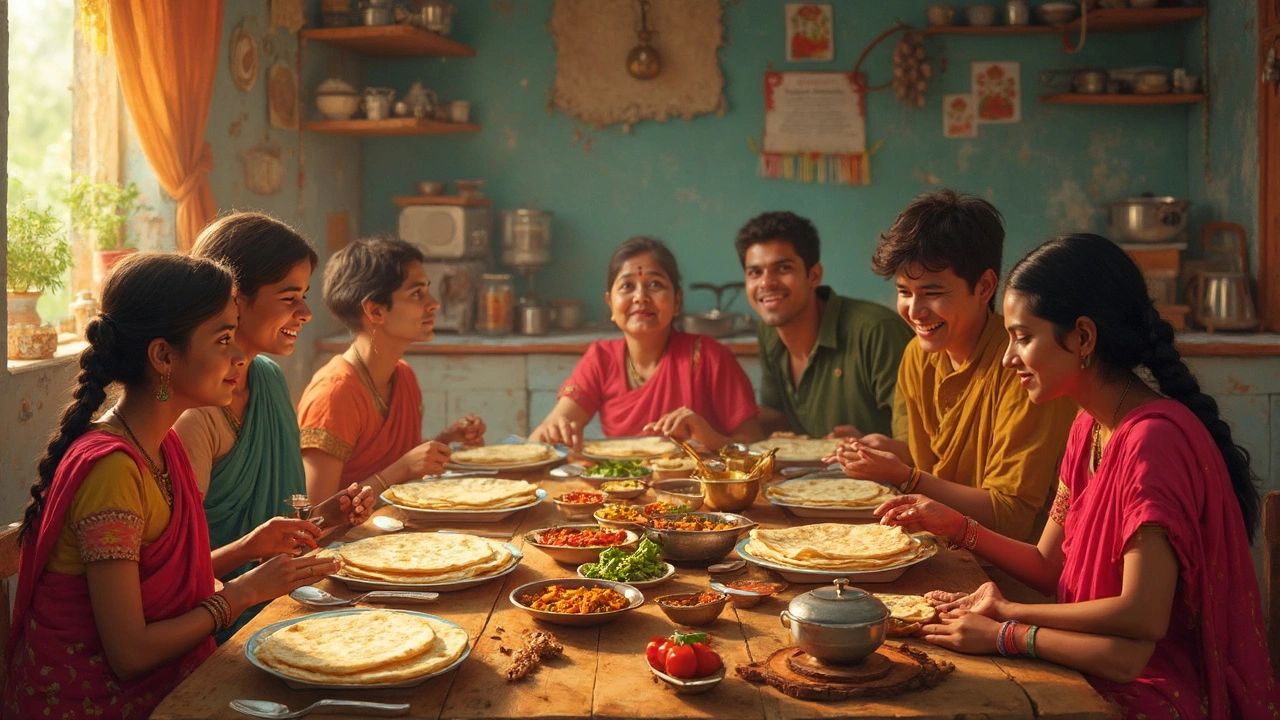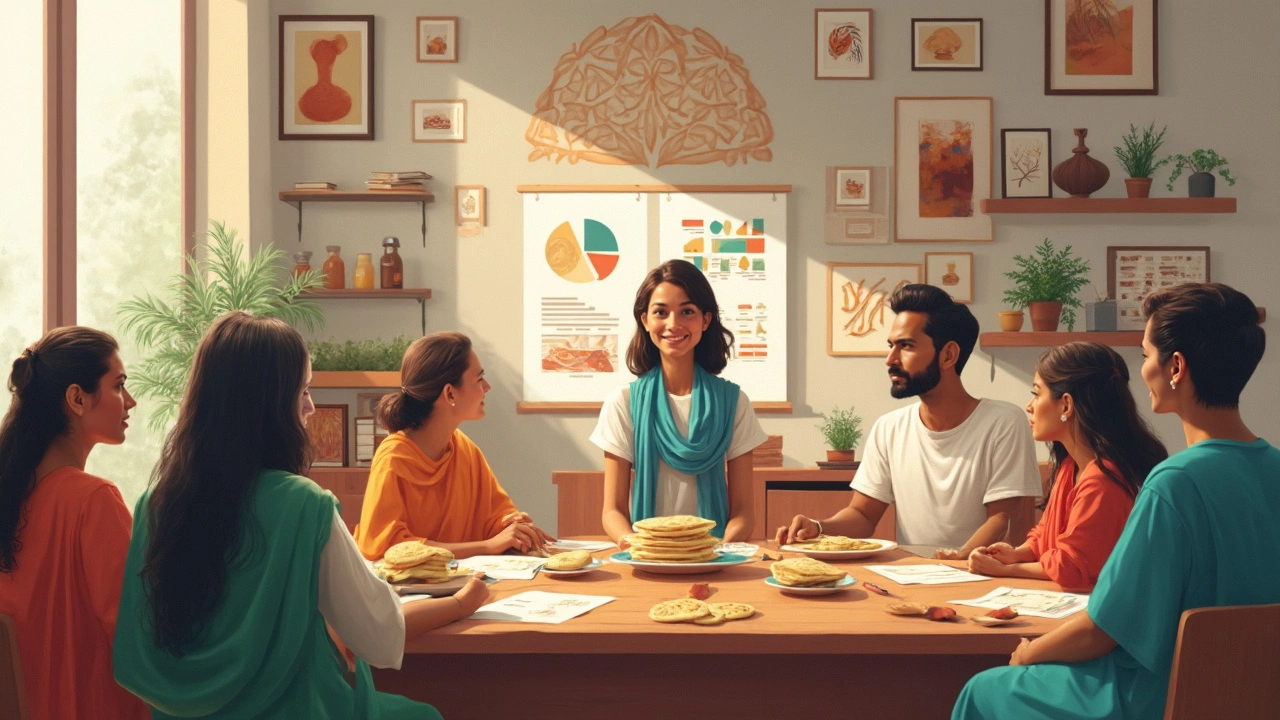Roti Calories Calculator: Track Your Daily Intake Easily
 Mar, 1 2025
Mar, 1 2025
Let's dive straight into understanding the calories in your rotis. Each roti, also known as chapati, is essential in Indian households and can fluctuate between 70 to 120 calories depending on size and ingredients. Seems straightforward, right? But there's more to consider when you're counting those calories.
To determine how many chapatis you should eat daily, think about your body's needs. This is where tracking your caloric intake with a calorie calculator comes in handy. A calorie calculator can tailor advice based on your weight, activity level, and health goals.
Your Body Mass Index (BMI) also plays a crucial role here. BMI helps you understand your body weight status. It's something like a snapshot of how balanced your weight is regarding your height.
- Understanding Roti Calories
- Using the Calorie Calculator
- How Many Chapatis in a Day
- Legal Aspects of Nutritional Info
- Local Dietary Insights
Understanding Roti Calories
Roti, or chapati, is a staple in many Indian diets, and knowing calories in one roti can help you manage your dietary intake effectively. A standard roti made from whole wheat flour can have about 70 to 120 calories. The variation in calorie count depends on the size and thickness of the roti, along with any additional ingredients like ghee or oil.
If you're wondering why these numbers matter, it's all about maintaining a balanced diet. Knowing how many calories you're consuming with each roti can make tracking easier using a calorie calculator. Typically, an average Indian diet includes about 3 to 4 chapatis per meal, but this varies with individual health goals and BMI.
Roti vs. Other Carbs
Ever compared the calories in a roti to other carbohydrates like rice? Surprisingly, one serving of rice contains almost double the calories compared to a single roti of the same weight. Hence, if you're aiming for a low-calorie diet, rotis might be a more balanced choice.
"A simple shift from rice to rotis can significantly lower calorie intake without compromising on nutrition," says nutritionist Rujuta Diwekar.
Legal Aspects and Nutritional Labels
From a legal standpoint, understanding the nutritional value on packaging is crucial. The Food Safety and Standards Authority of India (FSSAI) mandates clear nutrition labels, helping you stay informed about what's in your roti. Whether you're buying branded flour or packaged rotis, look out for this information. It guides you to make healthy choices.
Calorie Intake Tips
- Opt for whole grain flour to maximize fiber and reduce sugar levels.
- Limit the use of ghee or oil during cooking to maintain lower calorie counts.
- Pair your rotis with high-protein vegetables or dals for a balanced meal.
Locally, it's common to have more personalized nutrition advice from community-based dietitians. They often provide tailored advice considering locally available foods and typical dietary patterns. So next time you're planning meals, remember that the balance of calories matters, and understanding how many chapatis you should eat in a day can keep you on the healthier side.
| Food Item | Calories |
|---|---|
| 1 Roti | 70-120 |
| 1 Serving of Rice | 180-220 |
Using the Calorie Calculator
Tracking roti intake doesn't have to be rocket science. A calorie calculator can help you decide how many chapatis you can enjoy each day without overdoing it. Here’s a simple way to get started.
How to Use the Calculator
First things first, find a reliable online calorie calculator. Look for one that lets you enter personal details like age, weight, and activity level. These are crucial factors in determining your daily calorie needs.
- Enter your current weight and height. If you're not sure how these relate, check your BMI using quick online tools.
- Input your daily activity level. Are you mostly sitting or always on the go? Choose the one that matches your lifestyle.
- Set your health goals. Are you looking to lose, maintain, or gain weight?
The calculator will do the math, giving you a perfect estimate of daily calories needed. From there, figure out how much of that can be used for rotis, keeping in mind calories in one roti.
Legal Stuff You Should Know
While calorie calculators are super helpful, they rely on the accuracy of food labels. In India, it's mandatory for packaged foods to display nutritional information, but this doesn't always include fresh items like rotis. Be cautious and use trusted sources to verify your inputs.
Considering Local Diets
Most Indian meals revolve around chapati. Hence, tools have started incorporating typical Indian diets for more accurate results. If you're using a calculator, it should ideally have options for local foods.
Understanding your Body Mass Index (BMI) and using a calorie calculator can guide you to a balanced diet. Keep a close watch on how many Chapatis Should You Eat in a Day, ensuring you enjoy what you love without compromising health.

How Many Chapatis in a Day
Figuring out the exact number of chapatis you should eat in a day isn't about a one-size-fits-all approach. Instead, it's all about personalizing your diet according to your unique energy needs.
Step-by-Step Guide
Here's a simple guide on how to determine your daily chapati intake:
- Calculate Your Daily Caloric Needs: Use a calorie calculator to estimate your daily caloric needs based on your age, weight, height, and activity level.
- Understand Calories in One Roti: Know that an average chapati contains approximately 80-120 calories, depending on its size and thickness.
- Determine Your BMI: Check your Body Mass Index (BMI). A normal BMI ranges between 18.5 and 24.9. This will give you a better picture of your health status.
- Consider Your Daily Diet: Align the calories from chapatis with your total daily caloric intake to ensure you're not overboard.
Local Dietary Insights
In India, chapatis are a staple, and people consume them at every meal. But the key is balance, especially considering the variety of foods in Indian cuisine. Usually, consuming about 3-4 chapatis a day, alongside veggies, dal, and a portion of protein, works well for maintaining a balanced diet.
Legal Aspects of Nutritional Information
Providing accurate nutritional information voluntarily is a good practice even though it is not strictly enforced legally in all areas in India. However, consumer awareness about the nutritional value of chapatis is becoming more common, and people are urged to know what they're eating.
If you're making significant diet changes, consulting with a nutritionist or healthcare provider is always a good idea. Local regulations do not mandate detailed nutritional labeling for homemade foods, but when buying packaged chapati flour, check for nutritional info to make informed choices.
Legal Aspects of Nutritional Info
Ever wondered how the food labels on your rotis came to be standard? In India, the Food Safety and Standards Authority of India (FSSAI) mandates that food manufacturers adhere to specific labeling norms. This ensures the nutritional info you see is precise and useful.
Understanding the FSSAI Guidelines
The FSSAI guidelines require food producers to display comprehensive nutritional information. This includes calories in one roti, total fats, carbohydrates, proteins, and much more. These regulations are meant to help consumers make informed dietary choices and keep track of their calorie intake using tools like a calorie calculator.
Steps to Verify Nutritional Labels
- Check the Packaging: Ensure that the information on the packet is clear and readable.
- Look for FSSAI License Number: This number ensures that the product has been vetted.
- Compare Labeling: Use your calorie calculator to check if the nutritional claims hold up with your dietary requirements.
Importance of Accurate Labeling
Correct nutritional info is not just helpful; it's legally obligatory. Misleading labels can result in legal action, ensuring that producers strive for accuracy. Accurate labeling empowers you to decide how many chapatis you should eat in a day based on your Body Mass Index (BMI) and overall health goals.
Local Compliance and Brands
Numerous local brands, aware of these regulations, align themselves with FSSAI to provide reliable product info. It's beneficial to support these compliant local entities, as they contribute to transparency and consumer trust.
In a nutshell, understanding the legal aspects ensures you are not in the dark about the calories in one roti and that you use this info effectively in your diet plan.

Local Dietary Insights
Dietary habits in India are as diverse as its culture. Understanding local food practices can greatly influence how many chapatis you should eat in a day. Most traditional Indian meals include roti as a staple, but the number can vary based on regional food habits, climate, and urban or rural settings.
Regional Differences
In Northern India, due to the cooler climate, people often consume more rotis than in Southern India, where rice is prevalent. This difference isn't just cultural but also dietary, as it caters to varying nutritional needs influenced by the weather.
Urban vs. Rural Consumption
Urban areas might see a shift towards fewer rotis as people lean more towards varied diets that include other flatbreads, grains, and international foods. In contrast, rural regions adhere more closely to traditional diets, with chapati being a primary source of daily calories.
Using a Calorie Calculator Locally
When using a calorie calculator, consider these local habits. While the average calorie count of one chapati is about 100 calories, the portion size and accompaniments can affect your daily intake.
Legal Aspects of Nutritional Information
In India, food packaging laws require nutritional information labels, making it easier to track what goes into processed and packaged foods. Staying informed about these labels can guide your daily roti consumption and overall diet planning.
| Region | Average Chapatis Per Day |
|---|---|
| North India | 6-8 |
| South India | 2-4 |
Understanding these local dietary insights can help you use your Body Mass Index (BMI) effectively to plan a balanced diet that suits your lifestyle. Plus, by being aware of legal nutritional info, you're better equipped to make informed choices, whether you live in bustling Mumbai or a serene village.